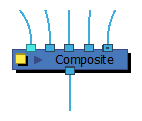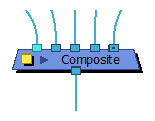Composite nodes have several modes, each of which can have a specific purpose in a complex node system:
-
As Bitmap: This is the default mode for composites. A bitmap composite outputs a single flat image.

-
As Seamless Bitmap: mode works very similarly to bitmap mode, except it prevents seams from appearing between vector shapes that have matching outlines or when vector drawings are 3D-rotated and made to mesh together.
 NOTE Shadow, Glow, Blending and Focus effects do not work when connected to a Seamless Bitmap composite.
NOTE Shadow, Glow, Blending and Focus effects do not work when connected to a Seamless Bitmap composite. -
As Vector: This mode outputs a flat vector drawing made of all the connected drawings. Vector composites should be used carefully, as they only work with vector layers and do not work with effects or bitmap layers.

-
Passthrough: This mode simply passes all the information sent to the Composite, including artwork, effects and transformation, onto the next composite as is, as a multi-layered image. This means that if an effect is applied to the output, the effect will be applied individually on each layer in the output image. Hence, a Passthrough composite does not really perform any composition and is essentially an organization tool.
 NOTE If a Composite set to Pass Through it is the last one in the compositing chain, it will act the same as a Bitmap composite.
NOTE If a Composite set to Pass Through it is the last one in the compositing chain, it will act the same as a Bitmap composite.
You can set a Composite node's compositing mode by opening its  Layer Properties dialog from the Node View and selecting the mode in the Mode drop-down.
Layer Properties dialog from the Node View and selecting the mode in the Mode drop-down.